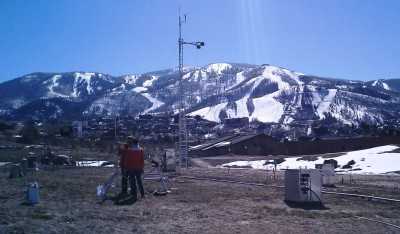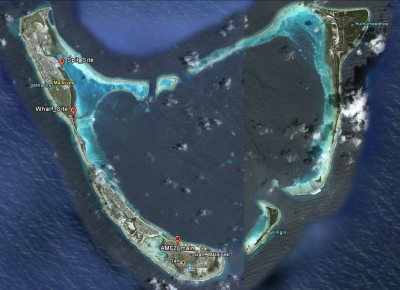From Snow to Sand; Mobile Facility Headed to the Maldives
Published: 20 May 2011
 After spending six very snowy months at Steamboat Springs, Colorado, the second ARM Mobile Facility (AMF2) is switching gears and heading to the tropical climes of the Maldives in the Indian Ocean. In mid-April, the Storm Peak Lab Cloud Property Validation Experiment (STORMVEX) came to a close, ending the final chapter of the AMF2’s maiden deployment. After packing up the instruments and data systems, the AMF2 team is now preparing for the long voyage to the Maldives for the ARM Madden-Julian Oscillation Experiment, or AMIE, which begins in October.
After spending six very snowy months at Steamboat Springs, Colorado, the second ARM Mobile Facility (AMF2) is switching gears and heading to the tropical climes of the Maldives in the Indian Ocean. In mid-April, the Storm Peak Lab Cloud Property Validation Experiment (STORMVEX) came to a close, ending the final chapter of the AMF2’s maiden deployment. After packing up the instruments and data systems, the AMF2 team is now preparing for the long voyage to the Maldives for the ARM Madden-Julian Oscillation Experiment, or AMIE, which begins in October.
STORMVEX. During the STORMVEX campaign, AMF2 instruments were located on the valley floor in Steamboat Springs, and at Christie Peak and Thunderhead Lodge about midway up Werner Mountain. Additional instruments operated at the Desert Research Institute’s permanent Storm Peak Laboratory at the summit, and a King Air research aircraft from the University of Wyoming conducted in situ sampling flights in January and February.
“For a first deployment, this experiment was very challenging,” said Brad Orr, AMF2 site manager from Argonne National Laboratory. “But with the dedication of the AMF2 technical staff, Storm Peak Laboratory, and the STORMVEX science team, it was ultimately a very successful campaign.”
Preliminary data obtained during STORMVEX and its eight related campaigns were presented at the Atmospheric System Research 2011 Science Team Meeting during the afternoon breakout sessions on Wednesday, March 30. They are available for reference on the meeting web page under “presentations.”

AMIE. For the AMIE campaign, all the AMF2 instruments will operate until April 2012 at the airport on Gan Island except for the cloud radar, which will be located near the wharf at Hithadoo Island to the north. These islands are part of the Addu Atoll, a series of small islands located at the south end of the Maldives. The Maldives is a group of about 1,200 islands separated into a series of coral atolls just north of the Equator in the Indian Ocean. Measurements from the ARM permanent site on Manus Island in Papua New Guinea will provide important context for AMIE and several related research efforts.
The upcoming AMIE campaign is part of the United States research contingent under the umbrella of the interagency Dynamics of the Madden Julian Oscillation, or DYNAMO project, led by the National Science Foundation and coordinated by National Center for Atmospheric Research. It is contributing to an overarching international effort called the Cooperative Indian Ocean experiment on intraseasonal variability in the year 2011, or CINDY2011. These efforts, endorsed by the World Climate Research Programme, will use planes, ships, and ground-based instruments to collect in situ atmospheric and oceanic data during an intensive observing period from October 2011 through January 2012.
Scientists will use data from CINDY2011, DYNAMO, and AMIE to study the MJO over the equatorial Indian Ocean, with a focus on the initiation process. Key scientific issues are: (1) evolution of moisture (and moist static energy); (2) relationships between the evolution and meso-scale convective systems; and (3) roles of the equatorial wave and sea surface condition.
The ARM Climate Research Facility is a DOE Office of Science user facility. The ARM Facility is operated by nine DOE national laboratories, including .
Keep up with the Atmospheric Observer
Updates on ARM news, events, and opportunities delivered to your inbox
ARM User Profile
ARM welcomes users from all institutions and nations. A free ARM user account is needed to access ARM data.


















